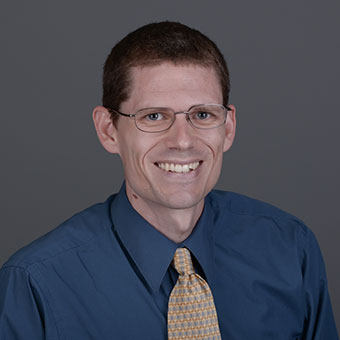
Soft robot devices driven wirelessly by light, or perhaps braille pages that rewrite themselves—they’re just two of the sorts of applications that Dr. Matthew Smith of the Hope College engineering faculty hopes will benefit from his research.
Soft robot devices driven wirelessly by light, or perhaps braille pages that rewrite themselves—they’re just two of the sorts of applications that Dr. Matthew Smith of the Hope College engineering faculty hopes will benefit from his research.
Supported through a new grant from the National Science Foundation (NSF), Smith is studying liquid crystal elastomers, rubbery materials that experience length changes of more than 300 percent when exposed to certain stimuli. He noted that they offer interesting possibilities for the design of devices whose very shape could be programmable and adaptable, but there’s just one problem: they aren’t easy to work with. Yet.
“Liquid crystal elastomers could be extremely useful for a variety of applications, such as soft, synthetic muscle actuators or rewriteable braille displays,” said Smith, an assistant professor of engineering who has taught at the college since 2012. Unfortunately, he explained, “Current approaches to fabricating responsive liquid crystal elastomers rely on elaborate procedures to align the liquid crystal units and represent a serious impediment to the widespread development of these materials for real applications.”
Smith will be developing a new, simpler technique for shaping the liquid crystal elastomers into the configuration that’s desired, or to adjust the initial shape as needed. It’s work so groundbreaking, and has such significant implications, that it’s received an 18-month award through the NSF’s “Early-concept Grants for Exploratory Research” (EAGER) program, which supports “exploratory work in its early stages on untested, but potentially transformative, research ideas or approaches. This work could be considered especially ‘high risk-high payoff’ in the sense that it involves radically different approaches, applies new expertise, or engages novel disciplinary or interdisciplinary perspectives.”
Smith emphasizes that his work is fundamental research, focused on developing understanding on which others can build. In the end, he hopes that he and the Hope students on his research team—working together during both the school year and summer—will provide a valuable tool that will help other engineers and applied scientists in (for example) the aerospace, biomedical, chemical and energy industries.
“What if engineers had the opportunity to design with these materials in complex two-dimensional or complex three-dimensional shapes? What could we imagine if we could enhance the functionality of the material?” he said. “I’ve always been interested in fundamental science from an engineering perspective. So I thought maybe I could develop the material and other people can see the benefit and can use it.”
The laboratory work continues an on-going area of interest for Smith, who’s already spent more than half a decade exploring the possibilities from a theoretical perspective.
“I’ve been working on responsive materials for the past six or seven years, before coming to Hope and including at Hope,” he said. “I’ve been developing mathematical models for the behavior of responsive polymers. This research will be an experimental foray into how we might build a responsive material with different abilities.”